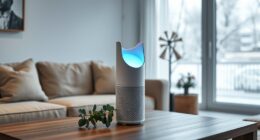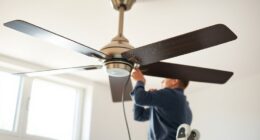Seasonal cleaning is essential for keeping your home fresh and welcoming. Each season comes with its own set of tasks to ensure your space is in top shape. During the winter, it’s important to check insulation and declutter. When spring rolls around, focus on deep cleaning and letting in fresh air by opening windows. Summer calls for cleaning air conditioning units and getting organized for fun activities. In the fall, take the time to inspect fireplaces and maintain outdoor areas. Using quality tools like HEPA vacuums and all-purpose cleaners will make your job much easier. Incorporating eco-friendly products not only improves air quality but also helps the environment. To help you stay organized, create a checklist to simplify the process and discover effective strategies for each season’s cleaning tasks.
Key Takeaways
- Create a seasonal cleaning checklist tailored to each season's specific tasks for effective organization and thoroughness.
- Deep clean your home in spring, focusing on thorough dusting, washing surfaces, and preparing for outdoor activities.
- In winter, ensure insulation and heating systems are checked, while decluttering indoor spaces for comfort.
- Prepare for summer by cleaning air conditioning units and organizing areas for seasonal activities and relaxation.
- Conduct fall maintenance tasks like inspecting fireplaces and cleaning outdoor spaces to prepare for colder weather.
Importance of Seasonal Cleaning
Seasonal cleaning transforms your living space, making it more inviting and comfortable. By following seasonal cleaning tips, you can enhance your home's aesthetic appeal while prioritizing a healthier living environment.
A well-structured cleaning routine, including decluttering and organizing, helps you tackle deep cleaning tasks that often get overlooked. Additionally, considering the importance of hiring a professional service can streamline your cleaning efforts and guarantee thoroughness.
Regular seasonal cleaning not only improves indoor air quality by reducing allergens and dust but also prevents long-term damage to surfaces and furnishings, preserving their functionality. This renewal and rejuvenation of your space support both mental well-being and physical health, allowing you to feel relaxed and productive in a tidy environment.
To effectively maintain a clean home, create a cleaning checklist that outlines tasks for each season. This way, you'll guarantee that every corner of your home receives attention and care.
Embracing the importance of seasonal cleaning empowers you to enjoy greater comfort within the home, making it a more enjoyable place to live. So, take the initiative today, and start your seasonal cleaning journey for a healthier and more inviting space! By staying on top of your home cleaning schedule, you can prevent clutter and dirt from accumulating, creating a more peaceful and organized living environment. Implementing a regular cleaning routine can also save you time and energy in the long run, allowing you to focus on the things that truly matter in your life. So, don’t hesitate to jumpstart your seasonal cleaning and establish a home cleaning schedule that works for you and your household.
Essential Cleaning Tools and Supplies

To achieve a thorough and efficient seasonal cleaning, having the right tools and supplies at your disposal makes all the difference. Investing in essential cleaning tools not only simplifies your cleaning process but also guarantees that your home's hygiene is maintained.
Incorporating an air purifier for cleaner air can greatly enhance your indoor environment by reducing allergens and dust. Here's what you need to have on hand:
- Vacuum Cleaner: A vacuum cleaner with HEPA filters is vital for effectively removing dust, dirt, and allergens, especially in high-traffic areas.
- Microfiber Cloths: These are perfect for dusting and cleaning surfaces without leaving streaks, making them a must-have in your toolkit.
- All-Purpose Cleaner: An all-purpose cleaner can be used on various surfaces like countertops and appliances, reducing the need for multiple products.
- Disinfectants: Keep disinfectants handy for maintaining hygiene in high-touch areas such as doorknobs and light switches to help minimize the spread of germs.
Additionally, don't forget mops and buckets—they're necessary for cleaning hard floors and tackling tough stains.
With these essential cleaning tools, your seasonal cleaning and overall home maintenance will become a breeze.
Seasonal Preparation Strategies

Preparing your home for each season is essential for maintaining comfort and efficiency throughout the year. Implementing effective seasonal preparation strategies guarantees your living space remains clean and organized while addressing the specific needs of each season. Here's a quick guide to help you stay on track:
| Season | Indoor Preparation | Outdoor Preparation |
|---|---|---|
| Winter | Check insulation and heating systems | Declutter indoor spaces |
| Spring | Deep cleaning and open windows | Prepare areas for planting |
| Summer | Clean air conditioning units | Organize spaces for summer activities |
| Fall | Inspect and clean fireplaces | Conduct outdoor maintenance tasks |
Regular maintenance and thorough cleaning are key to a comfortable home. Each season presents unique challenges, so tailor your cleaning approach accordingly. For instance, winter preparation involves confirming your home likely needs warmth and coziness, while spring focuses on rejuvenation. Remember, deep cleaning and maintenance should be a year-round commitment to keep your home efficient and inviting. By following these strategies, you'll create a welcoming environment for every season!
Cleaning Techniques and Strategies

Maintaining a clean and organized home involves employing effective cleaning techniques and strategies tailored to your space. To guarantee no task is overlooked, adopt a room-by-room approach by creating specific checklists for each area. This method allows for thorough cleaning, addressing the unique challenges that different rooms present.
Additionally, consider how your cleaning environment may affect your pets; for instance, using pet-safe products can help protect your cats from harmful substances. Focus on high-traffic areas during your maintenance cleaning to prevent excessive dust and dirt buildup. These spots often require more frequent attention due to daily use.
For deep cleaning, utilize techniques like washing walls and shampooing carpets to tackle accumulated dirt effectively. When selecting cleaning products, adapt to the specific needs of the materials you're cleaning. Use gentle solutions on delicate surfaces to avoid damage.
Additionally, schedule seasonal cleaning tasks to align with the unique needs of each season, such as gutter cleaning in the fall or air vent dusting in the spring. Be mindful of cat preferences and sensitivities when choosing scents and products to create a comfortable environment for your feline friends.
- Create checklists for each room
- Prioritize high-traffic areas
- Utilize deep cleaning techniques
- Schedule seasonal cleaning tasks
Eco-Friendly Cleaning Approaches

Embracing eco-friendly cleaning approaches not only benefits your home but also protects the environment. By using biodegradable and non-toxic cleaning products, you reduce harmful chemicals in your space, improving indoor air quality for your family and pets. Plus, homemade cleaning solutions made from vinegar, baking soda, and essential oils can handle most cleaning tasks effectively while minimizing your environmental impact.
Here are some simple eco-friendly cleaning swaps you can make:
| Eco-Friendly Swap | Traditional Alternative |
|---|---|
| Reusable cloths | Paper towels |
| Homemade cleaning solutions | Store-bought cleaners |
| Biodegradable sponges | Conventional sponges |
| Non-toxic detergents | Chemical-laden detergents |
| Cruelty-free products | Standard cleaning products |
Adopting sustainable cleaning habits, like those listed above, can greatly reduce waste and promote ethical consumerism. By choosing cruelty-free cleaning products, you support humane practices in production. Making these changes not only helps your home stay clean but also contributes to a healthier planet. So go ahead, embrace these eco-friendly practices and enjoy a cleaner, greener lifestyle!
Frequently Asked Questions
What Is a Good House Cleaning Schedule?
A good house cleaning schedule includes daily, weekly, monthly, and annual tasks.
Each day, make your bed and wipe down counters to keep things tidy.
Weekly, focus on high-traffic areas like vacuuming carpets and dusting surfaces.
Monthly, wash windows and check upholstery for stains.
Annually, tackle bigger tasks like decluttering your garage and deep cleaning kitchen cabinets.
This routine helps maintain organization and efficiency, making your home a pleasant place to live.
How Often Should You Clean Everything in Your House Chart?
Imagine your home as a canvas, where cleanliness paints a masterpiece of comfort.
You should aim for daily cleaning of high-touch surfaces and making your bed, while weekly tasks include vacuuming and bathroom upkeep.
Monthly, tackle neglected areas and inspect furniture.
For seasonal deep cleans, focus on appliances and air vents.
Finally, an annual clean should declutter and refresh spaces like your garage.
Staying on top of this keeps your home vibrant and inviting!
What Is a Cleaning Schedule?
A cleaning schedule is a structured plan that outlines specific tasks you need to tackle daily, weekly, monthly, and yearly.
It helps you break down larger cleaning projects into smaller, manageable tasks, ensuring you don't overlook any areas. By following a schedule, you build a routine, making cleaning less intimidating.
Plus, using a checklist can keep you accountable and organized, allowing you to prioritize what needs attention and track your progress effectively.
How to Set up a Cleaning Routine?
To set up a cleaning routine, start by identifying daily and weekly tasks.
You can make a checklist to tackle high-traffic areas and keep dirt at bay. Break larger projects into manageable steps, and schedule dedicated time for them.
Incorporate daily habits like making your bed and wiping surfaces to maintain cleanliness effortlessly.
Conclusion
So, now that you're armed with the ultimate seasonal cleaning guide, it's time to embrace your inner housekeeper. Sure, you could ignore those dusty corners and let the dust bunnies host their annual convention. But why not swap the couch cushions and channel your inner Marie Kondo instead? After all, nothing says "I've got my life together" like a sparkling home—until you spill your morning coffee, of course. Happy cleaning, and may the odds be ever in your favor!









